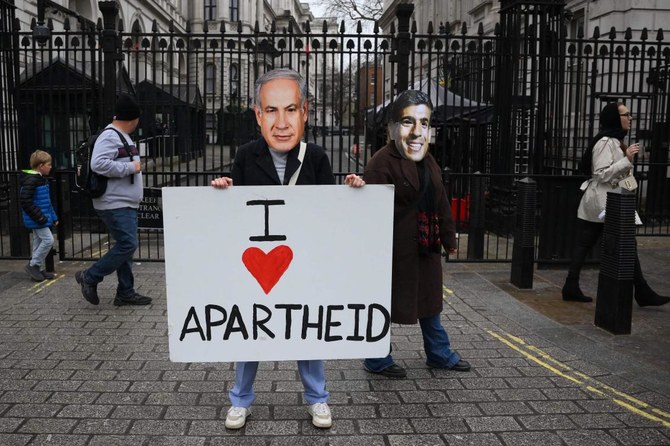LONDON: British Prime Minister Rishi Sunak held talks with Benjamin Netanyahu in London on Friday as protesters shouting “Shame!” In Hebrew demonstrated against the Israeli leader’s right-wing policies and his plans to overhaul the country’s judiciary.
Netanyahu had to pass by hundreds of protesters waving Israeli flags and waving signs calling for the defense of Israeli democracy as he arrived at 10 Downing St. for talks that focused on the war in Ukraine and concerns about Iran’s nuclear program.
Sunak also raised Netanyahu’s controversial judicial reforms, which have sparked mass protests in Israel and beyond. One placard in London read: “We are Israelis and Jews living in the UK demonstrating against Prime Minister Netanyahu, who is leading a judicial coup turning Israel into a dictatorship.”
Some women protesting outside Downing Street wore red robes and white caps inspired by “The Handmaid’s Tale,” a novel and TV series set in a dystopian future. Similarly clad demonstrators have become fixtures of the mass protests roiling Israel.
Sunak “stressed the importance of upholding the democratic values that underpin our relationship, including in the proposed judicial reforms in Israel,” the British leader’s office said in an official readout of the meeting.
Netanyahu’s proposals would give his government more control over judicial appointments, weaken the Supreme Court by limiting judicial review of legislation and allow Parliament to overturn court decisions with a simple majority vote.
He arrived in London as protesters in Israel blocked roads and clashed with police. The planned judicial system overhaul have ignited the biggest protests in the country’s history amid rare dissent from people throughout Israeli society, including military reservists, navy veterans, high-tech businesspeople and former officials.
Netanyahu’s right-wing government has also been criticized for its hard-line policy toward Palestinians, including recent comments by a government minister who denied the existence of the Palestinian people and their right to self-determination.
Sunak “reiterated our support for two-state solution,” and Britain’s view that Israel’s West Bank settlements are illegal and ”contrary to the cause of peace,” spokesman Jamie Davies said.
“Israel is a vital international partner for the United Kingdom, and the prime minister was visiting London, and this was an important opportunity to talk about issues that matter to both countries, whether that’s the threat of Iran, Russia, new trade and investment … as well as peace and stability in the Middle East,” Davies said.
Netanyahu’s office said the two leaders discussed the rapidly advancing nuclear program of Israel’s archenemy, Iran, as well as “deepening strategic cooperation in security, intelligence and economic fields.”
As thousands of people took to the streets across Israel on Thursday, Netanyahu, who is on trial for corruption, defiantly pledged to proceed with the judicial overhaul, hours after his coalition passed a law making it harder to remove him from office.
Rights groups and Palestinians say Israel’s democratic ideals have long been tarnished by the country’s 55-year, open-ended occupation of lands the Palestinians seek for an independent state and the treatment of Palestinian Israeli citizens, who face discrimination in many spheres.
Netanyahu pushed back his departure to Britain until 4 a.m. Friday to deal with the political crisis.


Protesters greet Netanyahu as he meets UK leader in London
Short Url
https://arab.news/64w9c
Protesters greet Netanyahu as he meets UK leader in London

- Sunak also raised Netanyahu's controversial judicial reforms
- Some women protesting outside Downing Street wore red robes and white caps inspired by “The Handmaid's Tale,” a novel and TV series set in a dystopian future
Ukraine says received 1,003 bodies from Russia
KYIV: Kyiv said on Friday that it had received from Russia more than 1,000 remains of people that Moscow said were Ukrainian soldiers killed fighting the Kremlin’s army.
The exchange of prisoners of war and the remains of killed soldiers is one of the few remaining areas of cooperation between Kyiv and Moscow, which invaded Ukraine in February 2022.
“Today, repatriation activities took place. 1,003 bodies, which the Russian side claims belong to Ukrainian servicemen, have been returned to Ukraine,” Kyiv’s Coordination Headquarters for the Treatment of Prisoners of War, said in a statement on social media.
Kremlin aide Vladimir Medinsky confirmed an exchange between Moscow and Kyiv had taken place, writing on Telegram that the Russian side had received the remains of 26 killed Russian soldiers.
Medinsky said the exchange was made possible as part of agreements struck between Ukrainian and Russian delegations in Istanbul earlier this year.
Tens of thousands of soldiers have been killed on both sides since Russia invaded, though neither side regularly publishes data on their own casualties.
The exchange of prisoners of war and the remains of killed soldiers is one of the few remaining areas of cooperation between Kyiv and Moscow, which invaded Ukraine in February 2022.
“Today, repatriation activities took place. 1,003 bodies, which the Russian side claims belong to Ukrainian servicemen, have been returned to Ukraine,” Kyiv’s Coordination Headquarters for the Treatment of Prisoners of War, said in a statement on social media.
Kremlin aide Vladimir Medinsky confirmed an exchange between Moscow and Kyiv had taken place, writing on Telegram that the Russian side had received the remains of 26 killed Russian soldiers.
Medinsky said the exchange was made possible as part of agreements struck between Ukrainian and Russian delegations in Istanbul earlier this year.
Tens of thousands of soldiers have been killed on both sides since Russia invaded, though neither side regularly publishes data on their own casualties.
© 2025 SAUDI RESEARCH & PUBLISHING COMPANY, All Rights Reserved And subject to Terms of Use Agreement.












